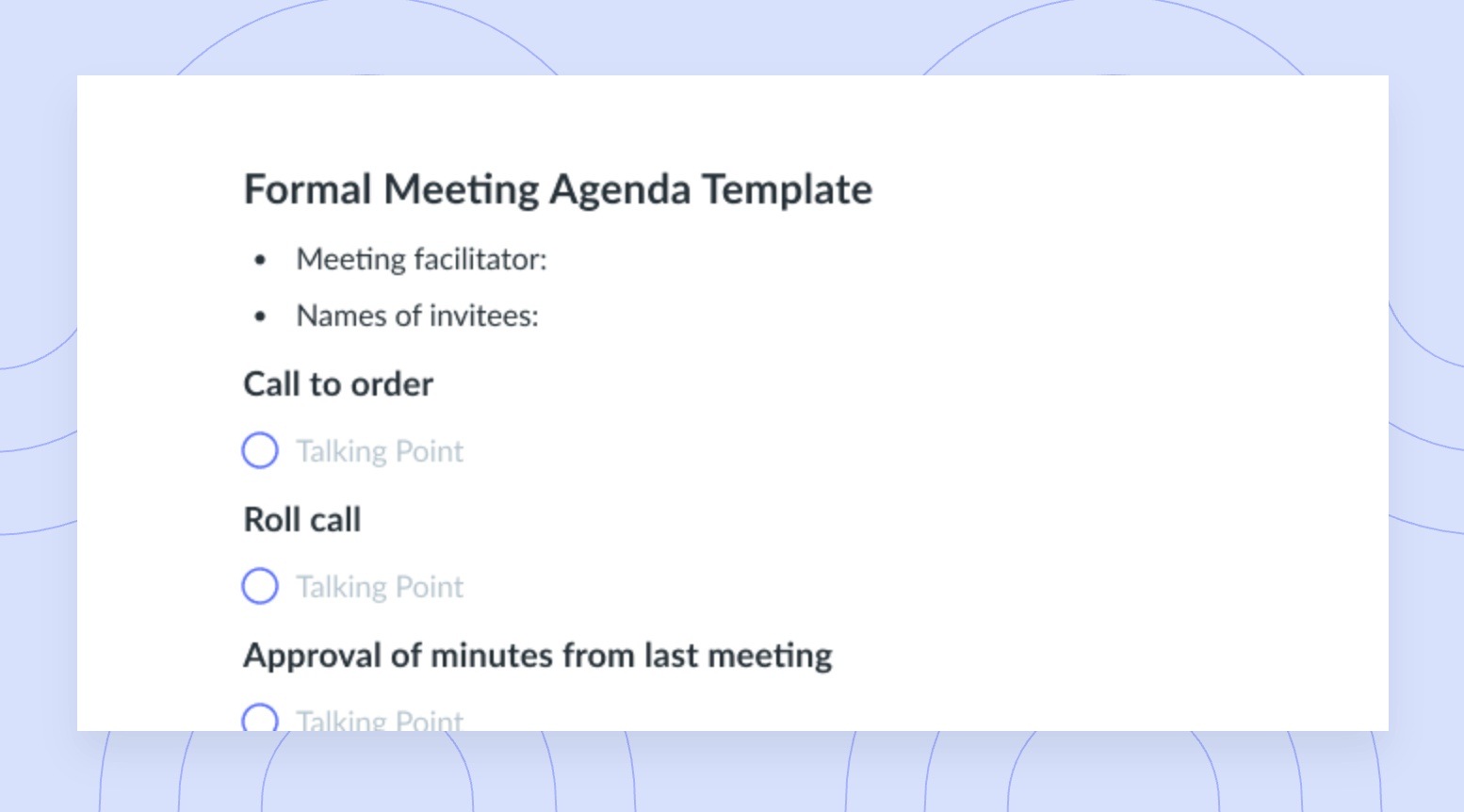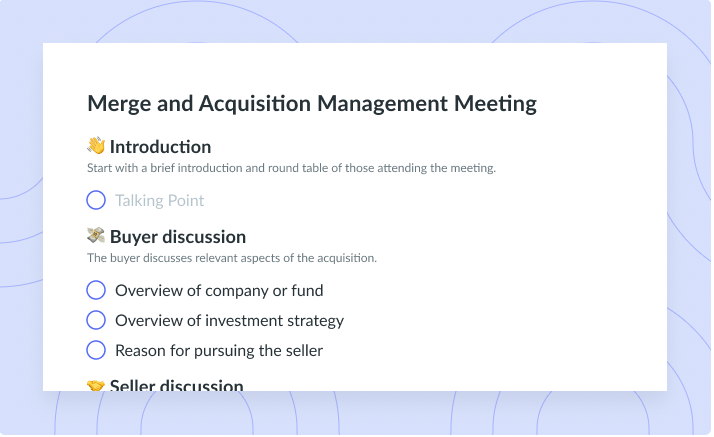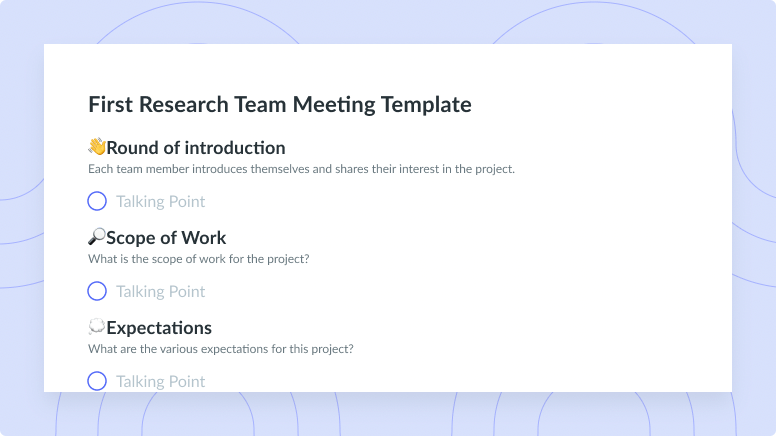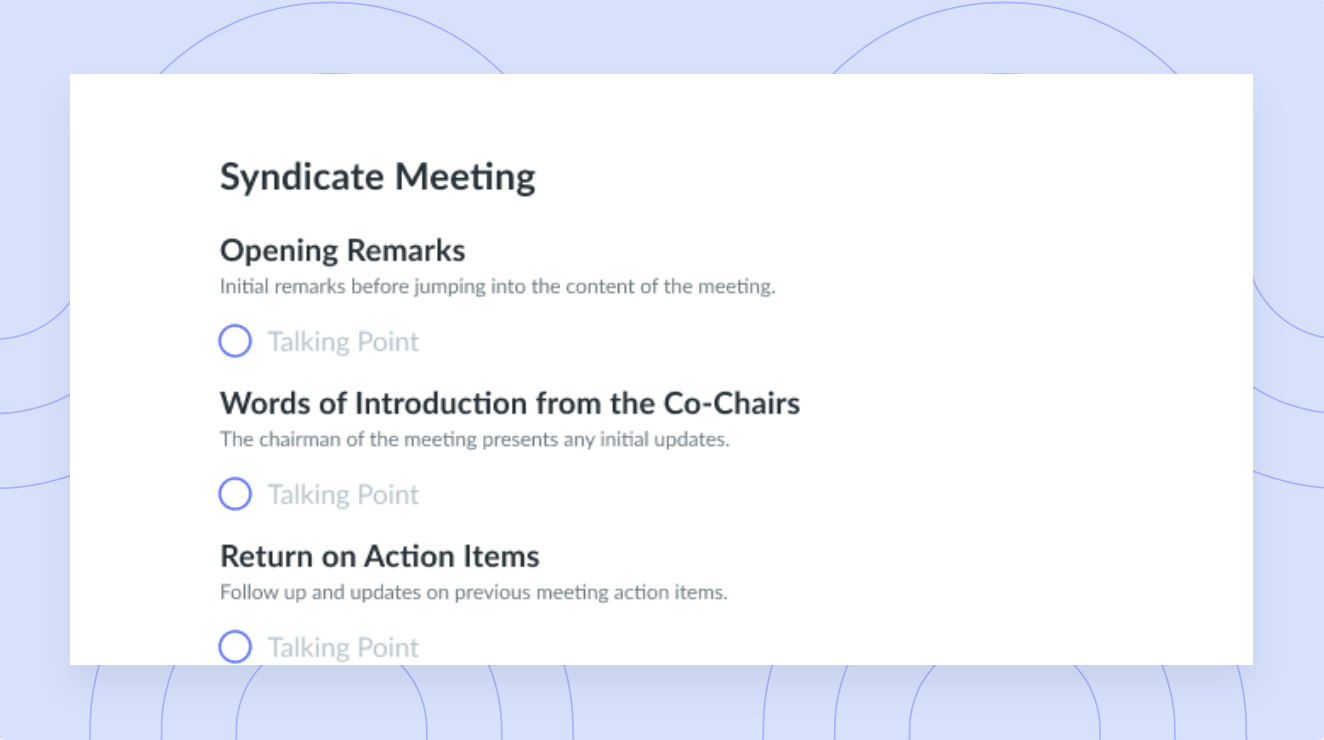Meeting Introduction Examples: The Power of First Impressions
How you begin a meeting matters. Explore the dos and don’ts of meeting introductions, and learn how you can use the IEEF framework to begin each meeting the right way.
What do a flustered host, the lack of a meeting agenda, and confused employees all have in common? They all indicate that a meeting is off to a bad start.
We’ve all attended meetings where we knew from the start that our time would be wasted. For a meeting to be productive, it must be organized, have a clear purpose, and have a prepared agenda.
If you regularly lead team sessions or one-on-ones, or you may need to host a meeting sometime soon, it’s important to learn how to introduce yourself in meetings. Read on to explore why the beginning of a meeting is important, learn the do’s and don’ts of meeting introductions, view examples of how you can begin a meeting on the right foot, and see some creative examples of how you can begin each meeting meaningfully.
- Why is the start of a meeting so important?
- Dos and don’ts of meeting introductions
- Meeting introduction steps and examples
- Ways to start a meeting
- How to start a meeting using the IEEI framework
- Start meetings off on the right foot with Fellow
Why is the start of a meeting so important?
The beginning of a meeting sets the tone and introduces the major themes for the entire session. On one hand, if a meeting host makes it clear at the beginning that they’re unprepared, attendees may take it as a clear sign that the meeting won’t be valuable. An organized host, on the other hand, shows employees that their attendance and efforts are valued and that the session will run smoothly.

Meeting introductions can transform the
effectiveness of your meetings
How a meeting begins can significantly influence engagement. Meeting introductions should briefly outline the meeting’s purpose and objectives, ensuring everyone is on the same page. With AI-generated meeting agendas, you get custom recommendations for impactful introductions based on meeting type, tone, and participants. Save time on preparation and get inspired with Fellow today!
If you want ideas on how to open a meeting, here are a few creative and engaging ways you can begin a meeting the right way:
- Celebrate wins
- Surprise your team with a fact or statistic
- Share a memorable quote
- Tell a personal anecdote
1Celebrate wins
Set a positive tone for your meeting by encouraging attendees to celebrate big and small wins. For example, the host could begin by congratulating the group on the recent success of a project, acknowledging a new hire, or giving an individual praise for leading a specific task. Alternatively, the meeting host can ask that each person give a shoutout to another member of the team. In doing so, the meeting host may lead attendees to begin associating group sessions with good news and team progress instead of boredom and mundane status updates.
2Surprise your team with a fact or statistic
An interesting way to begin each meeting is by offering the group a surprising statistic or fun fact to get everyone’s attention. The stat can be relevant to the meeting topic or completely irrelevant, depending on what tone you want to set. For example, if you want to captivate the group and make them smile, you can offer up a random fun fact like, “Did you know that avocados are a fruit, not a vegetable?” and ask that everyone else does the same. If you want to make the group feel motivated or get them thinking about the meeting topic, you can tell the group a statistic about your industry or organization.
3Share a memorable quote
Everyone loves a good quote! Quotes represent everything that people want to say but don’t know how. At the beginning of your next meeting, offer up a motivational or positive quote to deliver wisdom and provide a quick morale boost through well-worded thoughts. If you’re a “to the point” kind of leader, something quick-witted like, “The only place where success comes before work is in the dictionary” might work. Alternatively, if your team is facing any kind of adversity, a quote like, “Do not judge me by my success, judge me by how many times I fell and got back up again” might work well.
4Tell a personal anecdote
You can use the start of a meeting as an exercise in storytelling. If you want to grasp your attendees’ attention, share a real-life experience about a personal success, professional roadblock, or anticipated event. Discuss an experience that relates to the meeting topic, the group’s interests, or the team’s values. For instance, you can share a story about how a recent news event relates to your meeting topic, discuss new and exciting developments in your field, or tell a story about a recent professional success of yours.
Dos and don’ts of meeting introductions
Consider these dos and don’ts when kickstarting a meeting. Keeping these in mind will help you get things off to a productive and meaningful start.
- Don’t take too long. Remember to be respectful of attendees’ time and keep in mind that some may have a meeting after the one you’re leading. Keep the introduction short and sweet.
- Do include attendees. Try using the word “you” to get people excited about participating and having a conversation. Doing so will also highlight what’s in the discussion for them.
- Don’t overpromise or exaggerate. Be as transparent as you can regarding the state of the project and don’t promise unrealistic results by the end of the meeting.
- Do get creative. Done well, the introduction can be a time for you to have some fun and get attendees comfortable around one another.
- Do use Fellow for your introduction meeting agenda.
Meeting introduction steps and examples
Ready to kickstart the meeting with an introduction that sets the tone? Here are four steps for leading a meeting introduction, plus how to apply them to both informal and formal settings.
- Start with an introduction
- Announce the subject and duration of the meeting
- Explain the purpose
- Explain why the participants were chosen to be there
1Start with an introduction
It’s a good idea to start a virtual or in-person meeting by greeting everyone and introducing yourself. This can be especially helpful if there are attendees who may not know you because they’re new to the organization, or if you’re stepping in for someone else as the meeting facilitator.
- Informal: Hi everybody, I’m [your name], [your role] at [company name]. Thanks for joining the call today! I know most of you, but there are a few new faces! I’m excited to get started.
- Formal: Hello everyone, and thanks for joining. My name is [your name], and I’m the [your role] at [company name]. I appreciate everyone’s punctuality at this meeting. Let’s get started.
2Announce the subject and duration of the meeting
Next, you’ll want to make sure everyone is aware of the subject of the meeting so they have an understanding of what’s about to be discussed. You should also mention how long the meeting will last.
- Informal: We’re all here to discuss our very exciting upcoming product launch! This meeting should last about an hour.
- Formal: Today, we’re going to talk about our new product launch. The meeting will last an hour.
3Explain the purpose
Once the subject matter and duration have been established, touch on the purpose of the meeting. The last thing you’ll want is for attendees to be unsure why the meeting is taking place. Even though you should have had a clear purpose outlined in the agenda sent out before, it’s a good idea to remind everyone before the meeting gets started.
- Informal: When we’re done here today, we will have outlined a product launch schedule and assigned roles to everyone.
- Formal: Before this meeting concludes, a product launch schedule will have been established, in addition to everyone’s roles to make the launch a success.
4Explain why the participants were chosen to be there
Finally, go over why all of the meeting participants were chosen to be there. You don’t necessarily need to go person by person, especially if the meeting has a high number of attendees, but a brief comment about who is meeting will suffice.
- Informal: You’re all here because everyone in this room/on this call will play a huge part in ensuring the product launch is a success!
- Formal: Everyone in attendance today will play an integral part in launching the product on time to our customers.
Ways to start a meeting
You’re not limited to the IEEI framework, as there are other ways to start a meeting that can be considered. Consider these six alternatives if you’re looking for other ways to start a meeting.
- Make use of meeting templates
- Leverage small talk
- Roll call
- Use icebreakers
- Reiterate ground rules
- Outline the objectives
- Share quick status updates
1Make use of meeting templates
Get your meetings off to the right start by leveraging Fellow’s extensive library of expert-approved meeting templates, with pre-loaded meeting introduction sections for icebreakers or introductions. Check out our Remote Team Meeting Template or Hybrid Team Meeting Template to help you set a positive tone from the get-go.
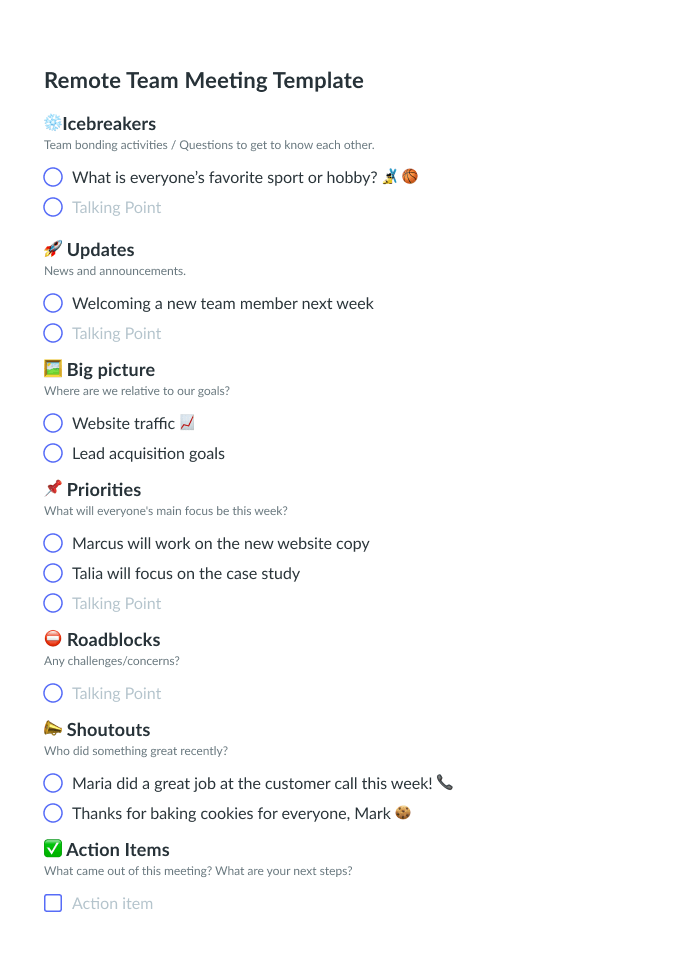
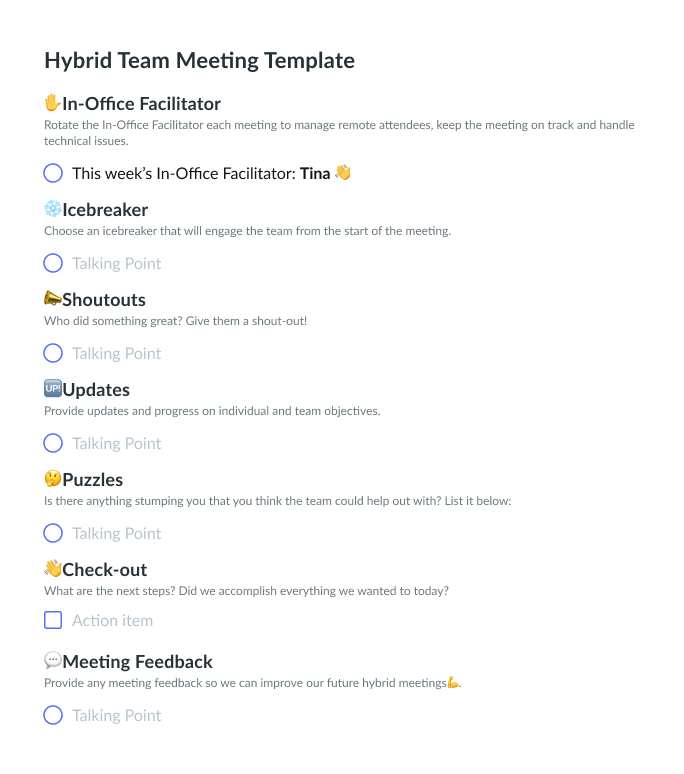
2Leverage small talk
People often roll their eyes when conversations veer into small talk—there are only so many times you can chat about the weather or your weekend plans. But small talk doesn’t have to be boring! Leveraging it the right way can help attendees know one another better.
Consider these outside-the-box small talk questions:
- Are you reading any good books right now?
- What’s your go-to comfort food?
- Would you rather have four ten-hour work days or five eight-hour work days?
Similar to an icebreaker, small talk is a great way to share a short conversation with attendees.
3Roll call
If the meeting you’re introducing is with a smaller group, taking attendance out loud is probably unnecessary. It’s likely that the person taking the meeting minutes will know everyone on a first-name basis and can note who is present and who isn’t in attendance.
If you’re leading a larger meeting that’s in person, you may choose to send around an attendance sheet. If someone vital to the matter being discussed is absent, it may be necessary to apologize for their absence and provide a short explanation as to why they’re not there.
An example of this is: You’ll probably notice that [name of CEO] isn’t here today as they were called away on business.
4Use icebreakers
You can also lean on icebreakers to start a meeting. These team-building questions can foster trust and build psychological safety with one another. There are a ton of options you can choose from! Some of our favorites are:
- What are your hobbies outside of work?
- What is your favorite thing to cook?
- What is your favorite reality TV show?
- Where is your dream vacation?
- Where is your favorite sit-down restaurant?
You may be surprised by the attendees’ answers!
5Reiterate ground rules
You can also start the meeting off by reminding everyone of the meeting ground rules. These are the standards or guidelines set up ahead of time that the attendees should follow for the meeting to be as productive and successful as possible.
Some examples of meeting ground rules are:
- State your name before you begin speaking
- Stay 100% focused during the meeting by avoiding incoming emails, direct messages, and text messages
- Never interrupt the individual who is speaking or sharing a point
- Come prepared with action items to discuss with the team
- Stay on topic to allow enough time for everything on the agenda
- Have your camera on when it’s your turn to speak during a virtual meeting
6Outline the objectives
Another alternative is to include an outline of the meeting objectives during the introduction. It’s far too common for attendees to join a meeting feeling like they have no idea what’s about to be discussed and what they’re expected to bring to the table. Establishing clear and concise objectives before a meeting starts can help avoid this confusion.
Some examples of how you can outline the objective during the meeting introduction are:
- “Thanks for joining this meeting! Today’s objective is to create a plan of action surrounding the new recruiting strategy for open positions that we’re looking to hire for this quarter.”
- “Thank you everyone for being on time for today’s meeting. The objective today is to develop a new plan to reduce customer churn in the second half of the year.”
- “Hi everyone! Thanks for joining on time. The objective today is to plan for the upcoming holiday party and discuss the theme, menu, and yearly awards.”
7Share quick status updates
Finally, sharing quick but informative status updates is another great way to start things off. Depending on how many people are in attendance, you can have everyone share two to three sentences about where they are on a project or initiative or, for larger meetings, have the leader of each team or department share pertinent updates on a need-to-know basis. This keeps everyone informed and accountable for what is being worked on by each team.
How to start a meeting using the IEEI framework
Too often, meeting hosts start sessions by diving straight into the first meeting agenda item. An ineffective beginning can set a negative tone for the remainder of the meeting, which is why it’s so important to start the meeting on the right foot.
At the start of each session, the host should state the purpose of the meeting, quickly review the agenda, and ask participants if they have any questions. One way leaders can learn how to address a meeting is by incorporating the IEEI framework into each group session.
IEEI stands for Inform, Excite, Empower, and Involve. Use this abbreviation as a reminder of what to include in the opening of your meeting remarks.
1Inform
At the beginning of the meeting, the host should inform attendees of the purpose of the meeting and the objective the group is striving to achieve. Let participants know why they’re there and what the group will have once the meeting is done to keep everyone on track. The start of the meeting should help participants understand why they’re in attendance and how their contributions during the session will help the group achieve its goals.
If helpful, you can use an opening line like, “The purpose of this meeting is to… At the end of the meeting, I want the group to have achieved…” to set the tone.
2Excite
In the second part of your meeting introduction, let attendees know why they should care about the topic at hand. Without excitement, morale and engagement may be low. in your opening remarks and meeting greetings, strive to use the words “you” and “your” multiple times in your opening remarks to indicate what’s in it for your participants.
Here is an example of opening remarks you can give as the host to excite the attendees:
- “Hello everyone! Thank you for joining me this morning to discuss our team’s hiring process. The purpose of the meeting is to simplify our recruiting process. When the meeting ends, this group will have three key OKRs to simplify our overall hiring process, a game plan for how to speed up our hiring moving forward, and a step-by-step process to procure new recruitment software. This is exciting because if we achieve these meeting objectives, this team will walk away with a newly simplified hiring process to make our work more efficient!”
3Empower
In the third step of the IEEI framework, ensure that all attendees are clear of the power they hold while in the meeting space. Empowering your teammates and stakeholders will encourage them to speak up and offer their thoughts, ideas, and insights. While you shouldn’t be corny, offering a simple, empowering statement in your opening remarks can be beneficial.
Here are a few meeting introduction ideas you can use to empower your meeting attendees:
- “You’re all here because your manager thought you were the best employees to work on this specific project. I’m really looking forward to hearing your thoughts on how we can move forward today and reach our goals!”
- “Our team is looking to all of you for your candid feedback and expertise on how we can ensure this new initiative is a success.”
- “Senior management is looking to this group to create recommendations that will guide the company’s mission and values into the future.”
4Involve
The final step of the framework is to involve attendees in the meeting conversation early so they are eager to participate throughout. At this stage, the meeting host should ask a question tied to the meeting’s objective. The goal of this step is to create an open and collaborative environment for everyone to contribute.
Here are a few examples of involvement questions you can ask meeting attendees:
- “If we’re going to achieve the outlined objective, there are a few key issues we should address in advance. Let’s have a conversation about these. In order to be successful today, what specifically must we address first?”
- “Now that you understand what we hope to achieve today, what other outcomes would you like to see come out of today’s session?”
- “It’s been a while since we’ve had a group session. Let’s begin by going around the table and having everyone give a quick one-minute update.”
- “What would make you say, “That was an amazing meeting!” at the end of this session?”
Start meetings off on the right foot with Fellow
If you regularly lead team meetings or 1-on-1s, learning how to start a meeting impactfully is crucial. To take your meeting introductions to the next level, leverage Fellow as your all-in-one meeting management software. Fellow offers AI-generated meeting agendas and custom recommendations to help you craft thoughtful and impactful introductions.
With our extensive library of expert-approved meeting templates, complete with designated introduction sections and icebreakers, you can set an engaging tone right from the start. You can also gather insights post-meeting with the meeting feedback feature on how the introductions and the overall meeting were perceived. This allows for continuous improvement of the meeting process. Start optimizing your meeting habits today!

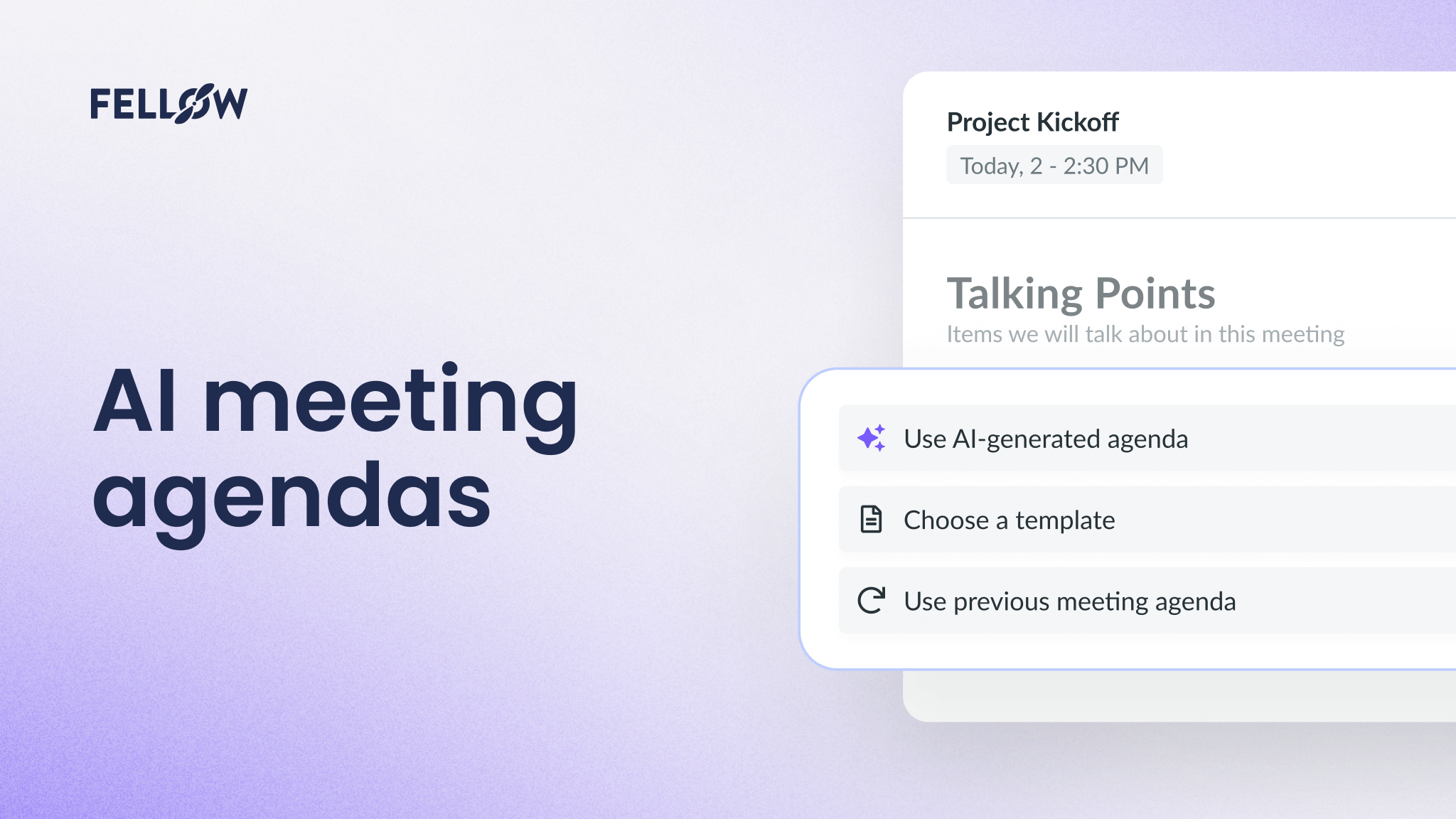



![Productive Tactical Meetings: 8 Tips [+ Free Templates]](https://fellow.app/wp-content/uploads/2022/08/Tactical-Meeting.jpg)




![How to Effectively Name Your Meetings [+Examples]](https://fellow.app/wp-content/uploads/2023/09/meeting-names.jpg)
